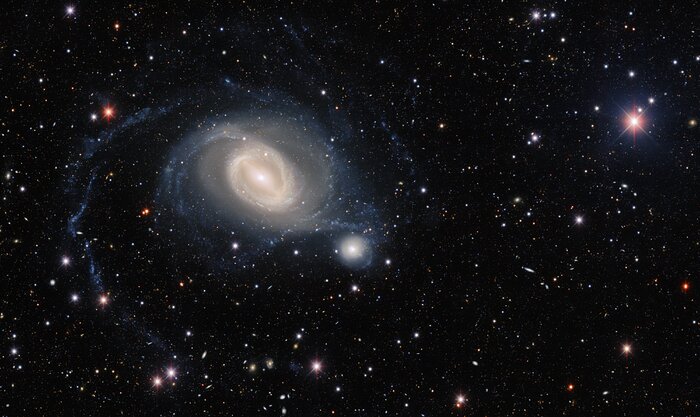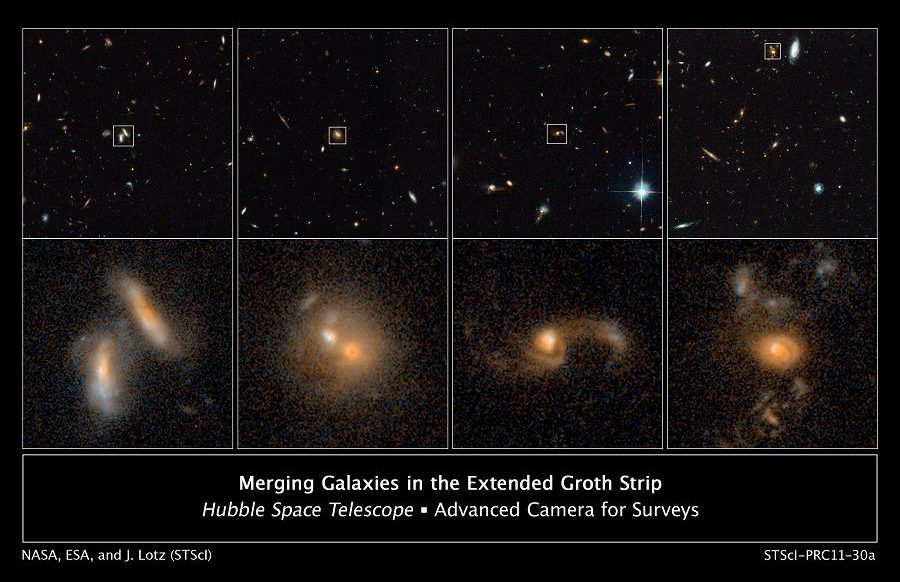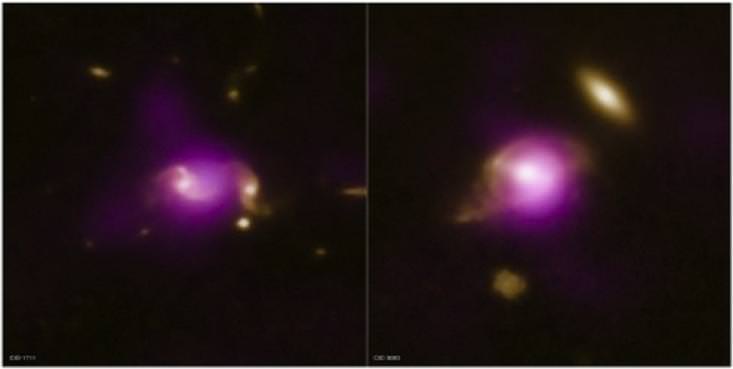[/caption]
Big galaxies… Little galaxies… But how often do they meet? Thanks to information from some of the latest Hubble surveys, astronomers have been able to more closely estimate galaxy collision rates than ever before. Apparently those that have happened within the last eight to nine billion years have occurred somewhere in-between previous estimates.
When it comes to galaxy evolution, the collision rate is an indicator of how individual galaxies accumulated mass over time. While it’s pretty much a standard measurement, there’s a large margin with no information of how often it might have occurred in the very distant past. By taking a look at in deep-field surveys made by NASA’s Hubble Space Telescope, astronomers were able to get a general look – one that showed a merger rate of anywhere from 5 percent to 25 percent of those studied.
The science team, led by Jennifer Lotz of the Space Telescope Science Institute in Baltimore, Maryland, took a close look at galaxy interactions spaced over vast distances. This allowed the group to essentially study mergers which occurred at different times. What they found was larger galaxies had a merger rate of once every nine billion years, while smaller ones crashed up more often. When taking a look a dwarf galaxies compared to massive ones, the team found it happened three times more often than the rate for large galaxies.
“Having an accurate value for the merger rate is critical because galactic collisions may be a key process that drives galaxy assembly, rapid star formation at early times, and the accretion of gas onto central supermassive black holes at the centers of galaxies,” Lotz explains.
While there were past studies of galaxy mergers done with Hubble information, astronomers used a different method and came up with different results. “These different techniques probe mergers at different ‘snapshots’ in time along the merger process,” Lotz says. “It is a little bit like trying to count car crashes by taking snapshots. If you look for cars on a collision course, you will only see a few of them. If you count up the number of wrecked cars you see afterwards, you will see many more. Studies that looked for close pairs of galaxies that appeared ready to collide gave much lower numbers of mergers than those that searched for galaxies with disturbed shapes, evidence that they’re in smashups.”
To help determine how often the merger rate occurred with time, Lotz and her team had to know how long an encountered galaxy would appear disrupted. In order to get a good working model, the team used computer simulations and then mapped them compared to Hubble images of galaxy interactions. While this effort took a great deal of time, the team did their best to create every possible scenario – from a pair of galaxies with equal mass to disparate ones. They also took into account orbits, collisional events and even orientation. Of these studies, 57 different situations and 10 viewing angles were accounted for. “Viewing the simulations was akin to watching a slow-motion car crash,” Lotz says. These computer created scenarios followed the galaxies for 2 billion to 3 billion years, starting at the merger beginning and ending a billion years later when completed. “Our simulations offer a realistic picture of mergers between galaxies,” explains Lotz.
While it was easy enough to see what happens with a giant galaxy, it was a bit more difficult to observe what happens with diminutive ones. Observing a dwarf merger is far more difficult simply because they are so much more dim – but plentiful. “Dwarf galaxies are the most common galaxy in the universe,” Lotz says. “They may have contributed to the buildup of large galaxies. In fact, our own Milky Way galaxy had several such mergers with small galaxies in its recent past, which helped to build up the outer regions of its halo. This study provides the first quantitative understanding of how the number of galaxies disturbed by these minor mergers changed with time.”
However, studies of this type just don’t happen with a handful of photos. Lotz and the team had to compare the simulations with literally thousands of galaxy images taken from some of Hubble’s largest surveys, including the All-Wavelength Extended Groth Strip International Survey (AEGIS), the Cosmological Evolution Survey (COSMOS), and the Great Observatories Origins Deep Survey (GOODS), as well as mergers identified by the DEEP2 survey with the W.M. Keck Observatory in Hawaii. At the beginning they found a wide variety of merger rates, but ended up with about a thousand merger candidates. “When we applied what we learned from the simulations to the Hubble surveys in our study, we derived much more consistent results,” Lotz says.
What’s next for Lotz and her team? It’s time to take a look at galaxy interactions that happened about 11 billion years ago. Their goal is to check out when star formation across the Universe reached its greatest as compared to the merger rate. Perhaps there might be a correlation between encounters and rapid star birth!
Original Story Source: Hubble Space Telescope News.





